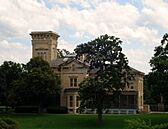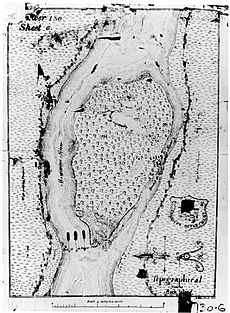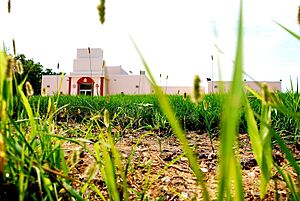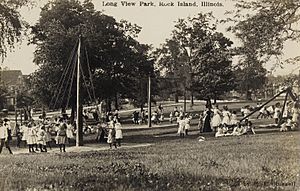Rock Island, Illinois facts for kids
Quick facts for kids
Rock Island, Illinois
|
|||||
|---|---|---|---|---|---|
|
|
|||||
|
|||||
| Motto(s):
Rock Solid, Rock Island
|
|||||
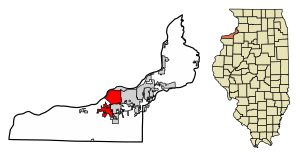
Location of Rock Island in Rock Island County, Illinois.
|
|||||
| Country | United States | ||||
| State | Illinois | ||||
| County | Rock Island | ||||
| Incorporated | 1841 | ||||
| Area | |||||
| • City | 17.07 sq mi (44.22 km2) | ||||
| • Land | 16.87 sq mi (43.70 km2) | ||||
| • Water | 0.20 sq mi (0.53 km2) | ||||
| Population
(2020)
|
|||||
| • City | 37,108 | ||||
| • Density | 2,199.51/sq mi (849.23/km2) | ||||
| • Metro | 384,324 (US: 147th) | ||||
| • CSA | 474,019 (US: 90th) | ||||
| Time zone | UTC−6 (CST) | ||||
| • Summer (DST) | UTC−5 (CDT) | ||||
| ZIP Codes |
61201, 61204, 61264, 61299
|
||||
| Area code(s) | 309 | ||||
| FIPS code | 17-65078 | ||||
| Interstate Spurs | I-280 | ||||
| Website | http://www.rigov.org/ http://www.rocksolidrockisland.com/ | ||||
Rock Island is a city in and the county seat of Rock Island County, Illinois, United States. The population was 37,108 at the 2020 census. Located at the confluence of the Rock and Mississippi rivers, it is one of the Quad Cities along with neighboring Moline and East Moline in Illinois and the cities of Davenport and Bettendorf in Iowa. The Quad Cities had a population of 384,324 in 2020. The city is home to Rock Island Arsenal, the largest government-owned weapons manufacturing arsenal in the US, which employs 6,000 people. The original Rock Island, from which the city name is derived, is now called Arsenal Island.
Contents
History
European-American Settlement
The original portion of what is now known as Rock Island was called Farnhamsburg – after the original two homes were built by Colonel George Davenport and Russell Farnham in 1826. Davenport and Farnham were business partners, trading with the local Native Americans. The original city plat was filed on July 10, 1835, and was named Stephenson. It was renamed Rock Island in March 1841.
The southern portion of Rock Island, including today's Watch Hill area, was originally known as Searstown. It was named after David B. Sears - who built the Sears Power Dam on the Rock River. Searstown was annexed by Rock Island in 1915.
This area has been a fortuitous place first for settlement and then for steamboat traffic, bridges, and railroads.
Railroads and development
The Chicago, Rock Island & Pacific Railroad (RI) was founded here in 1851, known informally as the Rock Island Line; over the next century, the railroad grew to serve fourteen states but ended in bankruptcy in 1980. As part of later nineteenth-century development, two first-class hotels: the Harper House (built by Ben Harper and opened in February 1871) and the Rock Island House were built in town. The Rock Island Arsenal has manufactured military equipment and ordnance for the U.S. Army since the 1880s.
The Rock Island Southern Railway was an interurban line that ran from Rock Island to Monmouth, Illinois, then onward to Galesburg, Illinois. It was built between 1906 and 1910. A portion of the trackage, from Rock Island to Preemption, Illinois, was shared with the CRI&P line that served the coal mines in Cable, Illinois, and Sherrard, Illinois. The line finally folded in 1952.
Bridges
Due to its geography, Rock Island has a rich history of bridge building, including the first railroad bridge across the Mississippi (now gone), an unusual two-track railroad bridge, and the largest roller dam in the world.
The first railroad bridge across the Mississippi River was built between Arsenal Island and Davenport in 1856. Many steamboat pilots felt that the bridge had been intentionally positioned to make it hard for them to navigate, and this conflict reflected a larger rivalry: St. Louis and its steamboats against Chicago and its railroads. Two weeks after the bridge opened, the steamboat Effie Afton collided with the bridge, caught fire, and damaged the bridge. The owner of the Effie Afton sued the bridge company for damages, and the case, Hurd v. Rock Island Bridge Co., featured Abraham Lincoln as one of the lawyers who defended the railroad at trial in September, 1857. This test case was appealed to the United States Supreme Court, which ruled in favor of the railroad in 1862. Although the original bridge is long gone, having been replaced in 1866 with a heavier bridge, a monument exists on Arsenal Island marking the Illinois side. On the Iowa side, the bridge was located near where 4th and Federal streets intersect with River Drive.
The Lock and Dam No. 15 and the Government Bridge are located just southwest of the site of the first bridge. The Government Bridge, completed in 1896, is notable for having two sets of railroad tracks above the car lanes. There are only two bridges in the world with this feature. Three other bridges span the river between Rock Island and Davenport. The Crescent Rail Bridge is a railroad-only bridge, completed in 1899. The Centennial Bridge was completed in 1940 for autos only. The newest bridge is the Interstate 280 bridge, completed in 1973. Lock and Dam No. 15, completed in 1934 as a federal Works Progress Administration (WPA) project during the Great Depression, is the largest roller dam in the world. The dam is designed for navigation, not flood control. During flood season, the rollers are raised, unleashing the full flow of the water.
On the south side of the city, overlooked by the Black Hawk State Historic Site, are auto and railroad crossings of the Rock River to Milan, Illinois. This set of bridges also crosses the historic Hennepin Canal and Sears Dam (this was named after the entrepreneur David B. Sears, who previously built the Sears Dam between Arsenal Island and Moline.) In 2007 a new bridge was completed between 3rd Street Moline/southeast Rock Island and Milan. It expedites the trip to Milan, the airport, and points south on U.S. Route 67.
Geography
Rock Island is located at 41°29′21″N 90°34′23″W / 41.48917°N 90.57306°W (41.489083, -90.573154).
According to the 2010 census, Rock Island has a total area of 17.872 square miles (46.29 km2), of which 16.85 square miles (43.64 km2) (or 94.28%) is land and 1.022 square miles (2.65 km2) (5.72%) is water.
Climate
|
||||||||||||||||||||||||||||||||||||||||||||||||||||||||||||||||||||||||||||||||||||||||||||||||
Demographics
| Historical population | |||
|---|---|---|---|
| Census | Pop. | %± | |
| 1850 | 1,711 | — | |
| 1860 | 5,130 | 199.8% | |
| 1870 | 7,890 | 53.8% | |
| 1880 | 11,659 | 47.8% | |
| 1890 | 13,634 | 16.9% | |
| 1900 | 19,493 | 43.0% | |
| 1910 | 24,335 | 24.8% | |
| 1920 | 35,177 | 44.6% | |
| 1930 | 37,953 | 7.9% | |
| 1940 | 42,775 | 12.7% | |
| 1950 | 48,710 | 13.9% | |
| 1960 | 51,863 | 6.5% | |
| 1970 | 50,166 | −3.3% | |
| 1980 | 46,821 | −6.7% | |
| 1990 | 40,552 | −13.4% | |
| 2000 | 39,684 | −2.1% | |
| 2010 | 39,018 | −1.7% | |
| 2020 | 37,108 | −4.9% | |
| 2022 (est.) | 36,256 | −7.1% | |
| U.S. Decennial Census 2010 2020 |
|||
| Race / Ethnicity (NH = Non-Hispanic) | Pop 2000 | Pop 2010 | Pop 2020 | % 2000 | % 2010 | % 2020 |
|---|---|---|---|---|---|---|
| White alone (NH) | 29,485 | 26,464 | 21,910 | 74.30% | 67.83% | 59.04% |
| Black or African American alone (NH) | 6,741 | 6,987 | 7,135 | 16.99% | 17.91% | 19.23% |
| Native American or Alaska Native alone (NH) | 87 | 84 | 63 | 0.22% | 0.22% | 0.17% |
| Asian alone (NH) | 290 | 680 | 1,603 | 0.73% | 1.74% | 4.32% |
| Pacific Islander alone (NH) | 17 | 8 | 12 | 0.04% | 0.02% | 0.03% |
| Other race alone (NH) | 53 | 66 | 160 | 0.13% | 0.17% | 0.43% |
| Mixed race or Multiracial (NH) | 670 | 1,065 | 1,928 | 1.69% | 2.73% | 5.20% |
| Hispanic or Latino (any race) | 2,341 | 3,664 | 4,297 | 5.90% | 9.39% | 11.58% |
| Total | 39,684 | 39,018 | 37,108 | 100.00% | 100.00% | 100.00% |
2010 Census
In 2000 Census, there were 39,684 people, 16,148 households, and 9,543 families residing in the city. The population density was 2,492.0 inhabitants per square mile (962.2/km2). There were 17,542 housing units at an average density of 1,101.6 per square mile (425.3/km2). The racial makeup of the city was 77.13% White, 17.17% African American, 0.28% Native American, 0.75% Asian, 0.07% Pacific Islander, 2.41% from other races, and 2.19% from two or more races. Hispanic or Latino of any race were 5.90% of the population.
There were 16,148 households, out of which 26.4% had children under the age of 18 living with them, 41.2% were married couples living together, 14.2% had a female householder with no husband present, and 40.9% were non-families. 34.5% of all households were made up of individuals, and 14.3% had someone living alone who was 65 years of age or older. The average household size was 2.31 and the average family size was 2.97.
The city's population was spread out, with 23.0% under the age of 18, 13.1% from 18 to 24, 25.7% from 25 to 44, 21.9% from 45 to 64, and 16.3% who were 65 years of age or older. The median age was 36 years. For every 100 females, there were 89.5 males. For every 100 females age 18 and over, there were 86.1 males.
The median income for a household in the city was $34,729, and the median income for a family was $45,127. Males had a median income of $32,815 versus $23,378 for females. The per capita income for the city was $19,202. About 10.9% of families and 14.5% of the population were below the poverty line, including 22.5% of those under age 18 and 8.4% of those age 65 or over.
Significant ethnic communities
Burmese community
Per the 2022 American Community Survey five-year estimates, the Burmese American population was 902 comprising 50% of the Asian population (estimated at 1,835).
Economy
Largest employers
According to the city's 2017 Comprehensive Annual Financial Report, the largest employers in the city are:
| # | Employer | # of Employees |
|---|---|---|
| 1 | Rock Island Arsenal | 6,301 |
| 2 | Trinity Rock Island | 1,848 |
| 3 | Rock Island–Milan School District 41 | 1,292 |
| 4 | Rock Island County | 733 |
| 5 | Jumer's Casino & Hotel | 550 |
| 6 | Augustana College | 550 |
| 7 | Pfg Tpc Roma Foods | 530 |
| 8 | City of Rock Island | 436 |
| 9 | Modern Woodmen of America | 435 |
| 10 | Honeywell Safety Products | 400 |
Rock Island County Courthouse
Construction began in April 2017 for a new Rock Island County courthouse. The $28 million project was completed in the fall of 2018, and the old courthouse was expected to be torn down upon completion of the new building. However, resident opposition delayed the demolition, with the phrase "Save Our Courthouse" being used by opponents to the demolition. The old courthouse was demolished in April 2023.
Education
The majority of the city is served by the Rock Island–Milan School District with portions of the southwest area falling under the Rockridge School District. The Rock Island–Milan School District is currently home to 13 public schools, with one high school, two junior high schools, nine elementary schools, and one alternative education center. Several private schools also serve Rock Island, including Jordan Catholic Elementary School and Alleman Catholic High School.
High schools
- Alleman High School
- Rock Island High School
- Rockridge High School (Taylor Ridge, Illinois)
Colleges
- Augustana College
- Bible Missionary Institute
Former schools
Villa de Chantal Catholic school closed in 1978, and the building was destroyed by fire in 2005. Schools that were closed and demolished include Franklin Junior High School, Central Junior High School, Lincoln Elementary School, and Audubon Elementary School.
Points of interest
- Augustana College (Illinois)
- Bally's Quad Cities Casino & Hotel
- Black Hawk State Historic Site
- Broadway Historic District
- Chippiannock Cemetery
- Hauberg Civic Center
- Longview Park Conservatory and Gardens
- Quad City Botanical Center
- Rock Island Public Library
- The Historic Rock Island Courthouse
- Rock Island Arsenal is a National Historic Landmark
Rock Island, Illinois is the site of the Quad City Hindu Temple, a Hindu shrine dedicated chiefly to the deity Venkateswara. The temple opened in 2007. Prior to its construction, Hindu worshippers had to travel to St. Louis or Peoria to participate in Hindu festivals and worship.
Cultural organizations
- Ballet Quad Cities
- Genesius Guild
- The Quad City Symphony Orchestra plays part of its Masterworks Series' concerts at Centennial Hall on the Augustana College campus.
- Quad City Arts
Sports
The first football game in what was to become the National Football League was played at Rock Island's Douglas Field in September, 1920. It was hosted by the Rock Island Independents (1907–1926), who were a charter NFL franchise in 1920.
The Rock Island Islanders were a minor league baseball team that played for 37 seasons between 1901 and 1948. The Islanders played at Douglas Park and were affiliates of the Cincinnati Reds and Philadelphia A's.
The Rock Island Legion Post 200 baseball team won the 4th State Championship in its history in 2011 in Galesburg, Illinois. Post 200 would finish 4th that year in the Great Lakes Regional.
Karters flock to Rock Island every year for the prestigious Rock Island Grand Prix on Labor Day weekend, which attracts competitors from across the United States and the world. With exception to 1997, when the annual race was canceled due to legal liability issues, the Rock Island Grand Prix has been held every year since 1994.
Rock Island High School has won state championships in basketball, girls and boys track, softball, and wrestling. Additionally the football and basketball programs are perennial powerhouses. Rock Island Public Schools Stadium has an artificial surface and has a seating capacity of over 15,000.
Media
Rock Island is the location of television station WHBF-TV. Until 1963, WHBF was one of only two television stations in the Quad Cities area. (The other is WOC-TV on the Iowa side of the river.) Rock Island was also the longtime former home of WHBF-TV's former sister radio stations, WHBF and WHBF-FM, although it does remain the licensed city of those stations.
Also, National Public Radio member station WVIK is licensed to and located in Rock Island on the campus of Augustana College, and WGVV-LP, which is also licensed to the city of Rock Island.
Rock Island is the home base for NOAA Weather Radio WXJ-73, the Quad Cities' area NWR station, programmed by the National Weather Service in Davenport.
Transportation
Quad Cities MetroLINK provides bus service on numerous routes connecting Rock Island to destinations across the Quad Cities. District Station in downtown Rock Island serves as a hub of the system.
Notable people
- David Ackles, singer-songwriter, pianist, and child actor
- Eddie Albert, Oscar-nominated actor and activist, known for television series, Green Acres and Switch, and films
- Black Hawk, leader and warrior of the Sauk American Indian tribe
- Ken Bowman, Ken Duncan and Herm Schneidman, players for NFL's Green Bay Packers
- John Buford, Civil war general
- George Davenport, American frontiersman, trader, U.S. Army soldier, and Indian agent
- Steve Decker, catcher with the San Francisco Giants, Florida Marlins, Colorado Rockies and Anaheim Angels
- Frederick Denkmann, lumber mogul and partner of Friedrich Weyerhäuser
- Pony Diehl, Wild West outlaw
- Booker Edgerson, Buffalo Bills
- Lane Evans, former United States Congressman (Illinois 17th District); born in Rock Island
- Russell Farnham, one of the first settlers of the area, and a partner of George Davenport
- Therese Fowler, author of “Z” and other books. Born and graduated high school in Rock Island
- Virginia Frederick, Illinois state representative
- Alan Garber - Provost and acting President of Harvard University
- Daniel G. Garnsey, former U.S. Congressman
- Aaron H. Grout, son of Governor Josiah Grout and Vermont Secretary of State
- June Haver, screen and radio actress; wife of actor Fred MacMurray
- Chase Hilgenbrinck, former professional soccer player with the New England Revolution
- Roger Imhof, actor and performer in motion pictures, vaudeville, burlesque and the circus
- Jesse Johnson, musician, guitarist for group "The Time", as well as solo artist
- Mark Johnson, Olympic wrestler and winningest wrestling coach at the University of Illinois
- Charles Keller, former U.S. Army Brigadier General and the oldest Army officer to serve on active duty during World War II. Served as district engineer for the area.
- Madison Keys, professional tennis player
- Lou Kolls, MLB umpire
- Kari Lake, news reporter, election denier, and political candidate in Arizona
- Helen Mack, screen and stage actress; born in Rock Island
- Jerry Mansfield, NFL player
- Elisabeth Maurus (aka Lissie), folk-rock singer and songwriter; born in Rock Island
- Tim Moore, stage, screen and television actor; first black TV star
- Don Nelson, forward and head coach with several NBA teams, most all-time wins as a head coach
- Greg Norton, former bassist of the hardcore punk band Hüsker Dü
- Gary Payton, astronaut
- Chasson Randle, basketball player and all-time leading scorer at Stanford
- Paul E. Rink, Illinois judge, lawyer, and politician
- Harry Sage, catcher with the Toledo Maumees
- Bobby Schilling, U.S. Congressman from Illinois's 17th congressional district
- Dred Scott, American slave who sued for his freedom
- J. Clinton Searle, Illinois state representative and lawyer
- Michael H. Sexton, Minor League Baseball executive
- Tom Sexton, shortstop with 19th century's Milwaukee Brewers
- Thomas P. Sinnett, Illinois politician and lawyer
- Charles A. Spring, Presbyterian leader and son of Samuel Spring
- Henry Strasak, Federal Bureau of Investigation (FBI) and Central Intelligence Agency (CIA) officer
- Lefty Taber, pitcher for the Philadelphia Phillies; born in Rock Island
- Hiram Truesdale, lawyer and jurist
- Jonathan Tweet, game designer, author, blogger
- Samuel Rinnah Van Sant, Civil War soldier, Governor of Minnesota 1901-05
- Henry Cantwell Wallace, U.S. Secretary of Agriculture 1921-24
- Friedrich Weyerhäuser, lumber mogul
- Bill Zies, catcher with the St. Louis Cardinals
- Lester Ziffren, journalist and Hollywood screenwriter
- Sherman McMaster, Wild West outlaw and lawman
See also
 In Spanish: Rock Island (Illinois) para niños
In Spanish: Rock Island (Illinois) para niños



